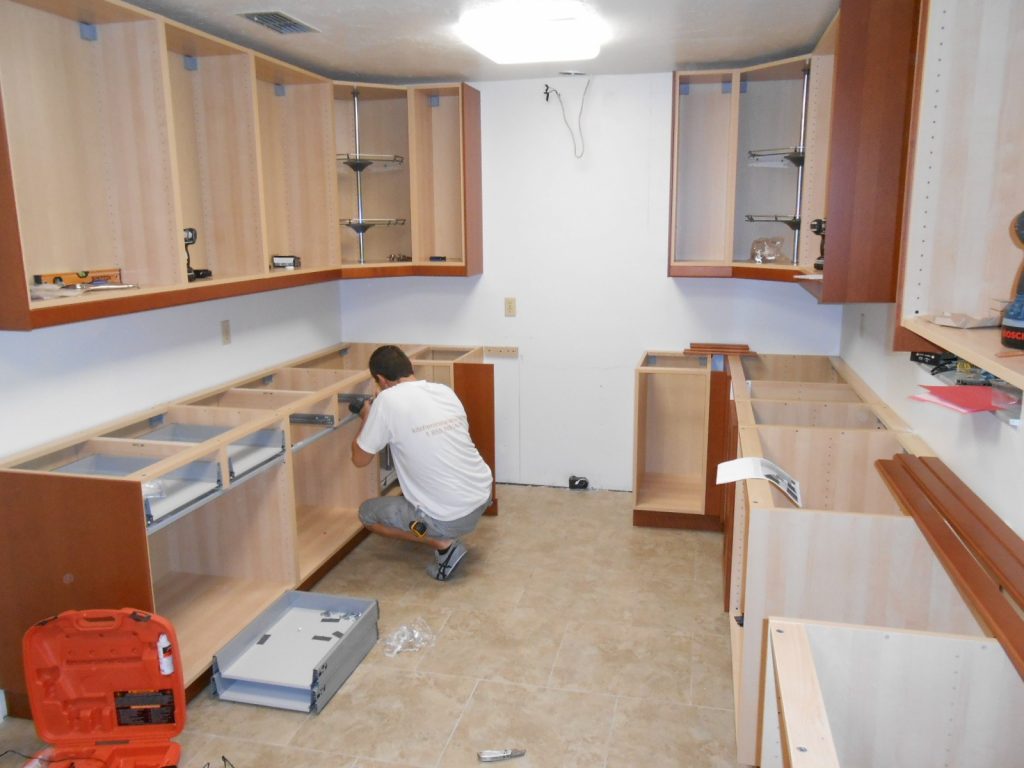Mountain View Cabinet Installation Tips
Handyman Services of Mountain View

TOP 11 Tips for Cabinet Installation Mountain View
- MEASURING FOR ACCURACY
Paying close attention to measuring details and rechecking for accuracy helps guarantee a smoother install. Of course, today’s installers have a battery of new technology at their disposal such as laser levels, laser measuring devices and even sophisticated software that can develop templates and measurements from photos.
On the low-tech side, installers in Europe frequently prefer folding rules over tape measures, citing increased durability and long-term accuracy. (Try pulling out five random 25-foot tape measures to their full length and see if they all agree!) Whatever measuring tools or system you use, the key is to be consistent.
- PRICE THE INSTALL SEPARATELY
Don’t forget to consider installation costs when pricing a job in the first place. Some shops even go so far as to separate installation from the cabinet bid. Typically, they give a firm contracted price for cabinets, but they offer an estimated cost for the installation, subject to change based on actual time and materials. If you do this, make sure to keep the client informed during the process to avoid any hassles when bill adjustments are needed.
- PLANNING, SCHEDULING AND COMMUNICATION
Smooth installs start with good planning and communication. Be sure to coordinate with other trades, builder, homeowner, designer, etc. Double-check for any last-minute changes. Some shops go so far as to call the homeowner the night before an install to remind them and make sure they understand about the noise, dust and disruption the installation may cause. Then you call again an hour before scheduled arrival to make sure you don’t have to wait for someone to finish up in the kitchen before you begin work.
Plan for the installation from the start of the job. Consider any stairs, elevators, hallways, building schedules, union rules, parking issues or other complications and plan for them up front.
Another good reason to plan well is it helps to develop ongoing relationships with builders, architects, designers and trades. That tends to help you get the next job.
- STAGING ELIMINATES SURPRISES
Complex jobs should be staged in the shop to make sure everything goes together smoothly at the job site. It might seem like assembling a project twice – once in the shop, then on the job site – is a waste of time, but it only takes one miscue for it to pay off. Once you are already on site it’s no time to find out that two cabinets don’t fit together the way they are supposed to. Discovering that while staging in the shop makes the fix lots easier and the install faster.
- TOOLS
Most efficient installers maintain a ready installation tool kit stored in the installation vehicle. That’s lots more efficient than raiding the shop for everything you need every time you go to the job site. Rolling, stackable toolbox systems make it easy to move tools from truck to work zone, and segmented drawers or dedicated pockets make it obvious if something is missing when you pack up at the end of the day.
Here are some more quick tool tips: Rather than carrying a bunch of screwdrivers, one driver with a magnetic head that takes the same interchangeable bits as your cordless drill driver saves space. Store tools and related jigs or fixtures together as they will be used, making sub-kits for special tasks, such as leveling boxes, scribing cabinets, or installing pulls.
- CONSIDER SOME SPECIAL TOOLS
Here are some special tools not in every installer’s kit but might be worth considering.
Consider a Japanese ryoba instead of conventional handsaw; it provides both rip and crosscut teeth and typically makes a finer, cleaner finish cut working on the pull stroke.
Blue masking tape works great for scribe lines. Tape the entire edge of the cabinet to be scribed, then mark the line right on the tape. The line is easier to see, and the tape protects the cabinet when cutting to the line. The blue-type masking tape also comes off cleanly without residue.
Cabinet lifting and propping devices can make it so one person can work more efficiently and safer if you are trying to keep from hiring extra help.
- SECURE AND SAFE SHIPPING
Too many cabinets are damaged in transit. Shrink wrap works better than tape to keep doors and drawers closed and secure in transit. Blanket wraps can provide extra protection. Some shops go so far as to screw down cabinets to walls and floor of the truck to make sure they don’t shift on the way.
Make sure you load the truck or trailer with the cabinets in the order required for the job. That way, what you need first comes off first, and nothing needs to be stacked or moved out of the way.
- UPPERS OR LOWERS FIRST?
Cabinet installers will probably never agree on whether upper or lower cabinets should be installed first. Installing upper cabinets first allows better access for lifting the cabinets in place, whether you use extra manpower or special tools such as cabinet lifts
But installing lowers first can also have advantages. If floors are uneven, leveling the lowers first is important to establish uniform spacing for the uppers. Some installers who put in lower cabinets first use a simple box as a combination lift and uniform spacer to position upper cabinets. Whatever system works best for your installation team is fine, but be consistent so everyone knows the routine.
- DEALING WITH DISCREPANCIES
Out of plumb walls and uneven floors seem to be a fact of life whether it’s new construction or 200-year-old antique home for the job site. Leg levelers, building a box platform, or just plenty of shims might be your answer. This is a case where staging in the shop won’t help unless you’ve replicated the uneven walls and floor there.
- KEEPING IT CLEAN
Working cleanly makes most jobs go more smoothly, but it’s absolutely essential in a remodel in an existing home. Bring protective plastic to protect carpets, entry and exit ways. Determine the least disruptive, most direct entry to the work area and make sure all installers use only that path. Use dust collection on all power tools and be diligent about cleaning up at the end of the day. Homeowners will remark at your concern for the cleanliness of their home.
- NO SNAGS AT THE END
After installation, dust off cabinets, then run a nylon stocking over anything at leg level. If it snags, sand with 600-grit paper or fine steel wool until it won’t snag the nylon.
Cost Of Cabinet Installation? Free Estimates! Call Today Or Schedule Cabinet Installation Online Fast!
CABINET INSTALLATION TIPS
How Much Does Cabinet Installation Cost? Kitchen Cabinet Install Estimates and Prices in Mountain View, CA – Handyman Services of Mountain View
Cabinet installation service cost? Cost breakdown. Labor: the direct labor to install kitchen cabinets, including planning, area preparation, setup and cleanup. Professional cabinet installers typically charge between $35-$65. According to IKEA, one can estimate installation of cabinets at 1.25 hours per cabinet. The cost to Install Cabinets starts at $60 – $280 per cabinet, but varies significantly with common options. Get real costs for your SPECIFIC project requirements here. See the time to install cabinets, along with per unit costs and material requirements. From inspiration to installation, you can trust Handyman Services of Mountain View every step of the way. We not only install kitchen cabinets, our kitchen project specialists perform thousands of installs a year, including kitchen cabinet replacements, kitchen cabinet repairs and full remodels. Best cabinet installation service and cost in Mountain View, CA!
- Labor Cost To Install Kitchen Cabinets
- Cabinet Installation Cost Lowes
- Kitchen Cabinet Installation Cost Home Depot
- How Much Does It Cost To Hang Cabinets
- Cabinet Installation Cost Per Linear Foot
- Labor Cost To Install Kitchen Countertops
- Cost To Install Countertops
- Cost To Install Ikea Kitchen Cabinets
- Cabinet Installation Service
- Cabinet Installation Price
- Cabinet Installation Edinburg
- Cabinet Installation Handyman
- Cabinet Installation
- Cabinet Repair
- Cabinet Painting
- Cabinet Replacement
Service area
- Mountain View, CA Cabinet Installation Tips
- Los Altos, CA Cabinet Installation Tips
- Sunnyvale, CA Cabinet Installation Tips
- Los Altos Hills, CA Cabinet Installation Tips
- Palo Alto, CA Cabinet Installation Tips
- Cupertino, CA Cabinet Installation Tips
- Stanford, CA Cabinet Installation Tips
- East Palo Alto, CA Cabinet Installation Tips
- Menlo Park, CA Cabinet Installation Tips
- Santa Clara, CA Cabinet Installation Tips
- Saratoga, CA Cabinet Installation Tips
- Campbell, CA Cabinet Installation Tips
- Milpitas, CA Cabinet Installation Tips
- Newark, CA Cabinet Installation Tips
- Redwood City, CA Cabinet Installation Tips
- San Jose, CA Cabinet Installation Tips
